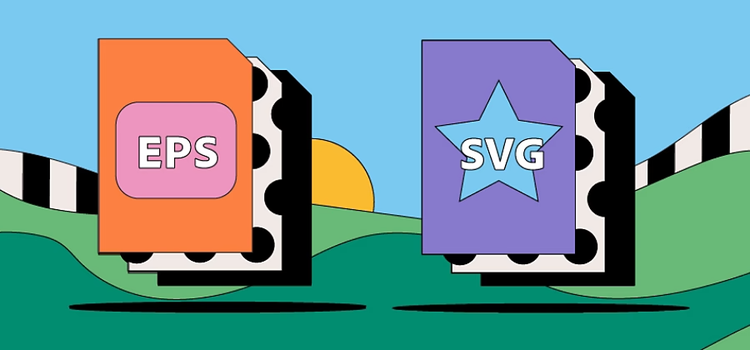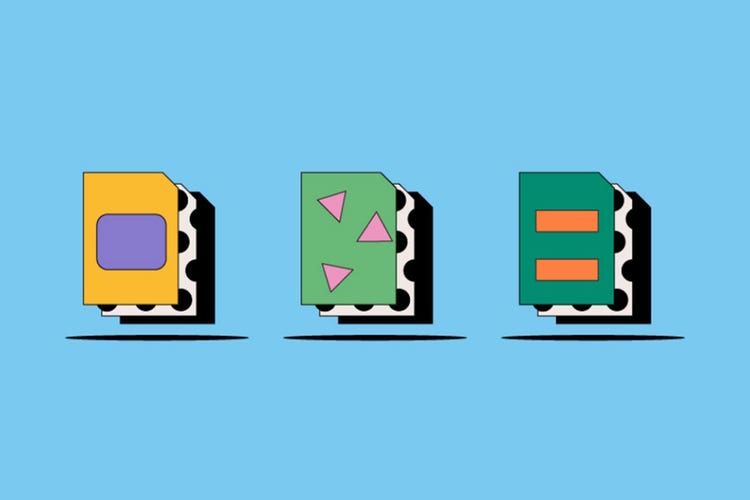DESIGN
EPS vs. SVG.
EPS and SVG are popular vector file types that provide detail and scalability without losing resolution. Learn about their similarities and differences, as well as which file might work best for your next project.

https://main--cc--adobecom.hlx.page/cc-shared/fragments/seo-articles/get-started-notification-blade
What is an EPS file?
EPS (Encapsulated PostScript) is the standard vector file format for the print industry. EPS files are a common choice for attention-grabbing, large-scale print ad formats like posters and billboards. They’re widely compatible between different operating systems, design programs, and printers — but many people see EPS as a legacy file. Native formats like AI and other vector file types like PDFs are slowly replacing them.
What is an SVG file?
SVGs (Scalable Vector Graphics) are an excellent choice for logos, icons, or any image that needs to appear sharp and high-quality, no matter the size. What sets SVGs apart from other vector files is that they use the text-based XML programming language. Search engines like Google can read XML in the SVG files, which can help with SEO. This makes SVGs particularly useful for graphic design on the web.
What is the difference between EPS and SVG files?
Though they’re both image-oriented vector files, there are several critical differences between EPS and SVG files.
Web use.
SVG files use both image and text-based data. The XML programming language that SVG files use stores text information as actual text rather than rendering it through vector-based shapes, dots, and algorithms. That means search engines can pick up SVG text, which helps web developers boost their rankings every time they use a new XML image.
EPS files launched in 1992, back when the digital landscape looked a lot different. As a result, EPS files are not well-optimized for the web.
Print.
Professional printers often use EPS files for large-scale ads and marketing materials. Though initially designed for PostScript printers, EPS files are compatible with a wide range of devices.
Their backward compatibility means legacy devices can use them, too. This means EPS files are a good option if you’re working with a printing business that uses older equipment, since it may struggle with modern file types.
You can use SVG files for some print work, particularly printing for clothing and crafting —but they’re not compatible with enough devices to rely on them for day-to-day tasks.
Scalability.
As vector files, both EPS and SVGs use a complex network of mathematical algorithms, points, lines, and polygons to display images. Because vector files can recalibrate themselves to stay the same at any size, they’re great for images that need to scale up or down.
SVGs are specifically designed for web use, so they aren’t usually ideal for large-scale printing. They work best at the size of a computer screen. So, when it comes to detailed charts, tables, or infographics that might require users to zoom in, they’re the perfect choice.
As print-oriented files, EPS files do a lot of heavy lifting for billboards and other large-scale print ads. They store additional coding information on color and size to help printers manage the task.
Design programs.
Programs like Adobe InDesign, Adobe Illustrator, and others support the EPS file type. However, EPS design functionality is more limited than the native .indd and .ai file formats.
Opening a vector file like EPS in a raster (pixel-based) program like Photoshop means you no longer have the same editing capabilities as you would in vector-based programs like Illustrator. Additionally, saving a design as an EPS file requires the input of specific settings for preview functionality. This extra step can slow down designers who work in fast-paced environments.
SVGs are also widely compatible with design programs. However, they lose certain elements of the original design file, such as guide information, when they’re compressed.
The simplicity and scalability of SVGs make them a popular option for crafting programs and devices, such as Cricut.
File sizes.
Another main difference between EPS and SVG file types is their size. SVG is smaller than EPS — consisting of code only. Their XML programming language helps boost load times and performance.
EPS file sizes are far larger because they contain more image information, including size and color.
How do I convert SVG to EPS?
To convert your SVG file to EPS using Adobe Illustrator, follow these steps.
- Open Adobe Illustrator.
- Choose File > Open and select your SVG file.
- Open your SVG file.
- Choose File > Save As.
- Select Illustrator EPS and adjust the settings.
- Save your new EPS file.
EPS vs. SVG: frequently asked questions.
Can I use EPS and SVG files for photos?
EPS and SVG are both vector-based formats. While vector files are excellent for producing crisp graphics, drawings, and designs at any scale, they struggle to reproduce photographs.
Raster-based files like JPEG, GIF, TIFF and PNG are better suited to photography. This helps render the color and complexity of a photograph.
Learn more about the difference between raster and vector files
Is the EPS format outdated?
Is SVG the best vector format?
https://main--cc--adobecom.hlx.page/cc-shared/fragments/seo-articles/do-more-illustrator-color-blade
